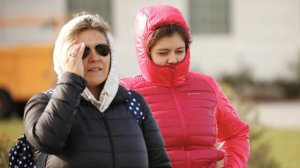Be sure to keep your winter coat handy because it’s about to get chilly in Los Angeles County — particularly the northern region.
The Los Angeles County Health Officer on Sunday extended a cold weather alert after the National Weather Service forecast low temperatures and wind chills below 32 degrees.
The affected areas include Antelope Valley through Saturday, Los Angeles County mountain areas through Thursday and Santa Clarita Valley until Tuesday.
Cold Weather Alert: Cold Temperatures Expected in Antelope Valley, Santa Clarita Valley and LA County Mountain areas. View https://t.co/YyFvYyN1Aa for more pic.twitter.com/ubyQoU55c7
— LA Public Health (@lapublichealth) December 15, 2019
Public health officials said children, the elderly and people with disabilities or have special needs can be especially vulnerable during this cold weather stint.

“Extra precaution should be taken to ensure they don’t get too cold when they are outside,” said Dr. Muntu Davis, Los Angeles County Health Officer. “There are places where people can go to stay warm, such as shelters or other public facilities. We also want to remind people not to use stoves, barbecues or ovens to heat their homes due to the risk of carbon monoxide poisoning.”
Here are some things to remember once the cold temperatures hit:
- Dress in layers of warm clothing if you plan to be outdoors.
- Protect head, hands and feet from cold.
- Check on and help family members, friends and neighbors with limited mobility and limited access to heat, such as seniors or those who are ill. Check on them frequently.
- If you have outdoor pets, bring them inside
- If you don’t have a heater in your home, visit indoor public facilities such as shopping malls, libraries or senior centers.
- The Los Angeles Homeless Services Authority has a winter shelter program available for those who need shelter. Locations and transportation information are online at https://www.lahsa.org/. Those interested can also call the L.A. County information line at 211 from any landline or cellphone.
In cases where people exposed to cold weather for prolonged periods of time, hypothermia could develop. Experience and symptoms may vary, depending on how long a person is exposed to cold temperatures.
The early symptoms of hypothermia include shivering, fatigue, loss of coordination, confusion and disorientation. Later symptoms include no shivering, blue skin, dilated pupils, slow pulse and loss of consciousness.
Frostbite is also possible for those exposed to extremely cold weather where snow or freezing happens. The most common affected areas of frostbite are the nose, ears, cheeks, chin, fingers or toes.
While heating your home during cold weather, carbon monoxide poisoning is a risk. Here are some tips to make sure it does not happen:
- Only use approved heaters, such as electric or natural gas heaters and fireplaces. Never use stoves, barbecues and ovens to heat your room or home.
- Install a carbon monoxide detector in your home.
- If you use an outdoor generator at home, place it at least 10 feet away from all doors and windows
For more information, call 211 or visit www.211la.org.





















